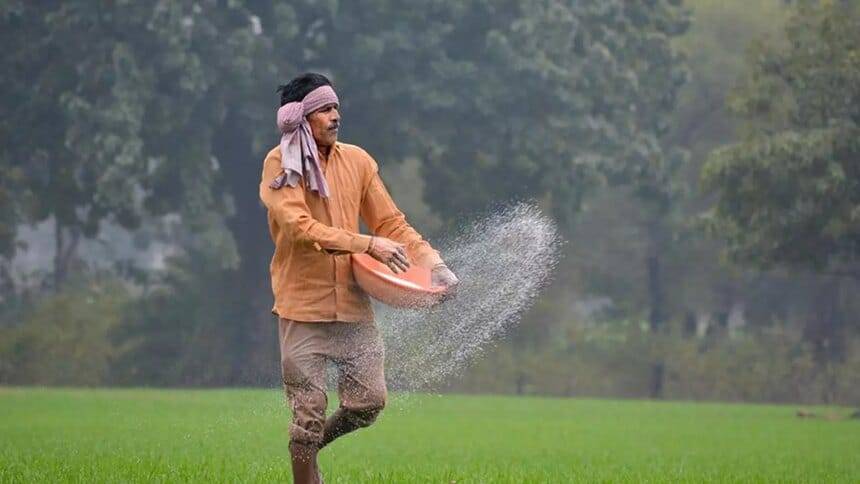Main Points In Hindi (मुख्य बातें – हिंदी में)
-
डीएपी बिक्री में गिरावट: चालू वित्त वर्ष के अप्रैल-अगस्त के दौरान डाइ-अमोनियम फॉस्फेट (डीएपी) की बिक्री में 20% से अधिक की गिरावट आई है, जबकि अन्य उर्वरकों की बिक्री बढ़ी है।
-
आयात में कमी: विशेषज्ञों का मानना है कि डीएपी के आयात में कमी के कारण यह स्थिति उत्पन्न हुई है, जहाँ 2023-24 की इसी अवधि में आयात आधा रह गया है।
-
रबी सीजन की तैयारी: किसानों को रबी बुआई के लिए आवश्यक मात्रा में डीएपी और अन्य जटिल उर्वरकों की कमी का सामना करना पड़ रहा है, जिससे गेहूं और सरसों की बुआई प्रभावित हो सकती है।
-
राजनीतिक आरोप: कुछ नेताओं ने केंद्र की नीतियों को डीएपी की कमी का मुख्य कारण बताया है, जिसमें कंपनियों को अन्य उत्पादों के साथ टैग करने के लिए मजबूर किया जाना शामिल है।
- राज्य सरकारों की चिंताएँ: पंजाब और मध्य प्रदेश की राज्य सरकारें केंद्र से डीएपी की आपूर्ति बढ़ाने की मांग कर रही हैं, ताकि किसानों को सर्दी की फसल के लिए आवश्यक उर्वरक उपलब्ध हो सकें।
Main Points In English(मुख्य बातें – अंग्रेज़ी में)
Here are the main points from the provided content regarding the decline in DAP fertilizer sales in India:
-
Decline in DAP Sales: There has been a significant over 20% decline in the sales of Di-Ammonium Phosphate (DAP) fertilizer during the April to August period of the current financial year, despite other fertilizers seeing an increase in sales.
-
Supply Shortage Amid Reports: Reports indicate a shortage of phosphate fertilizers in Punjab and Madhya Pradesh ahead of the rabi sowing season, raising concerns despite the drop in sales.
-
Import Issues: Experts suggest that the reduced DAP sales are linked to decreased imports, with DAP imports halving from the same period in the previous year.
-
Policy Criticism: Some stakeholders attribute the DAP shortage to government policies that compel distributors to bundle DAP with other products, leading to reluctance in procurement among distributors.
- Imminent Demand vs. Availability: There is a projected demand for DAP in the coming months for wheat sowing, with regional officials expressing concerns over shortages, as farmers are paying significantly more than the recommended price.


Complete News In Hindi(पूरी खबर – हिंदी में)
जबकि अन्य सभी उर्वरकों की बिक्री में वृद्धि हुई है, चालू वित्त वर्ष के अप्रैल-अगस्त के दौरान डाइ-अमोनियम फॉस्फेट (डीएपी) की बिक्री में 20 प्रतिशत से अधिक की गिरावट देखी गई है। इसने कई लोगों को आश्चर्यचकित कर दिया है क्योंकि रबी बुआई के मौसम से पहले पंजाब और मध्य प्रदेश में फॉस्फेटिक उर्वरकों की कमी की खबरें आई हैं।
उर्वरक मंत्रालय, जिसने दो साल पहले कमी को कारण बताकर सार्वजनिक डोमेन से मांग-आपूर्ति की जानकारी रोक दी थी, इस वर्ष कमी के कारणों को स्पष्ट नहीं कर पाया है। हालांकि, विशेषज्ञ आयात कम होने की ओर इशारा कर रहे हैं।
आधिकारिक आंकड़ों के अनुसार, चालू वित्त वर्ष के पहले पांच महीनों में डीएपी की बिक्री 38.36 लाख टन (लीटर) थी, जो एक साल पहले 48.26 लीटर से कम थी। यहां तक कि कृषि मंत्रालय के आकलन में भी 2024-25 में इस अवधि के लिए मांग 50.52 लीटर आंकी गई है।
दूसरी ओर, डीएपी का आयात 2023-24 की इसी अवधि में 31.05 लीटर से आधा घटकर 15.88 लीटर रह गया। केवल डीएपी ही नहीं, अन्य सभी उर्वरकों के आयात में भी गिरावट आई और यह गिरावट 4-23 प्रतिशत के बीच रही।
‘गलत नीति’
“डीएपी की कमी किसी भी अन्य मुद्दे की तुलना में केंद्र की गलत नीति के कारण अधिक है। उर्वरक कंपनियों को अन्य उत्पादों जैसे कीटनाशकों, कवकनाशी और सूक्ष्म पोषक तत्वों को डीएपी के साथ टैग करने के लिए मजबूर किया जा रहा है और परिणामस्वरूप वितरक पर्याप्त मात्रा में उठाव करने में अनिच्छुक हैं। मध्य प्रदेश कांग्रेस में किसान सेल के प्रमुख केदार सिरोही ने कहा, कुछ वितरक जो टैग की गई सामग्रियों को अनिच्छा से स्वीकार कर रहे हैं, वे किसानों के साथ भी ऐसा ही करने की कोशिश कर रहे हैं, और उन्हें डीएपी के साथ अन्य उत्पाद खरीदने के लिए कह रहे हैं।
उन्होंने आरोप लगाया कि मप्र में गेहूं की बुआई का प्रमुख समय अक्टूबर-नवंबर है और इस साल न तो डीएपी और न ही जटिल उर्वरक पर्याप्त मात्रा में उपलब्ध है। उन्होंने कहा कि किसान 50 किलो का डीएपी ₹1,700/बैग खरीद रहे हैं जबकि इसकी एमआरपी ₹1,350/बैग है।
सिरोही ने कहा कि मप्र में अक्टूबर में डीएपी की मांग 3 लीटर होने का अनुमान है, जबकि उपलब्धता 2 लीटर भी नहीं है, उन्होंने कहा कि गेहूं और सरसों दोनों को इसकी आवश्यकता है।
पंजाब सरकार भी डीएपी की कमी को लेकर चिंतित है और केंद्र से पर्याप्त मात्रा में डीएपी भेजने को कह रही है। जबकि पंजाब में गेहूं की बुआई नवंबर के पहले सप्ताह में शुरू होती है, आलू की बुआई अक्टूबर के मध्य में शुरू होती है और किसान अक्टूबर में डीएपी खरीदना शुरू करते हैं।
सरकारी पदयात्रा आपूर्ति
राज्य के अधिकारियों ने कहा कि सालाना इस्तेमाल होने वाली 8.5 लीटर डीएपी में से 5.5 लीटर अकेले रबी सीजन में इस्तेमाल हो जाती है और इस साल 3.5 लीटर की कमी है। हालांकि, केंद्रीय कृषि मंत्रालय के सूत्रों ने कहा कि मासिक मांग में कमी इतनी बड़ी नहीं है और सरकार अक्टूबर और नवंबर दोनों में आपूर्ति बढ़ाने की कोशिश कर रही है।
इस बीच, प्रमुख उर्वरकों – यूरिया, डीएपी, एमओपी और कॉम्प्लेक्स की कुल बिक्री (खपत) 3.7 प्रतिशत बढ़कर 253.06 लीटर से 262.47 लीटर हो गई, जबकि अप्रैल-अगस्त अवधि के लिए मांग 270.86 लीटर अनुमानित थी। यूरिया की बिक्री एक साल पहले के 153.98 लीटर के मुकाबले 2.8 फीसदी बढ़कर 158.23 लीटर हो गई, जबकि एमओपी की बिक्री 5.36 लीटर के मुकाबले 31 फीसदी बढ़कर 7.02 लीटर हो गई और कॉम्प्लेक्स की बिक्री एक साल पहले के 45.46 लीटर से 29.5 फीसदी बढ़कर 58.86 लीटर हो गई।
Complete News In English(पूरी खबर – अंग्रेज़ी में)
While sales of other fertilizers have increased, sales of di-ammonium phosphate (DAP) have dropped by over 20% during the current financial year from April to August. This has surprised many, especially as there are reports of a shortage of phosphate fertilizers in Punjab and Madhya Pradesh ahead of the Rabi sowing season.
The Ministry of Fertilizers, which had previously withheld information about demand and supply due to shortages, has not clarified the reasons for the current shortage. However, experts point to reduced imports as a significant factor.
According to official data, DAP sales in the first five months of this financial year were 3.836 million tons, down from 4.826 million tons last year. Even the Agriculture Ministry’s estimate projects a demand of 5.052 million tons for this period in 2024-25.
On the other hand, DAP imports have plummeted from 3.105 million tons during the same period in 2023-24 to just 1.588 million tons this year. Not only DAP but also imports of all other fertilizers have fallen, with declines ranging from 4% to 23%.
‘Poor Policy’
“The DAP shortage is primarily due to the central government’s poor policies. Fertilizer companies are being forced to bundle DAP with other products like pesticides and micronutrients, making distributors reluctant to buy in sufficient quantities. Kedar Sirohi, head of the farmer’s cell of the Congress in Madhya Pradesh, stated that some distributors who are grudgingly accepting the bundled materials are similarly trying to make farmers purchase DAP along with other products.
Sirohi alleged that the main wheat sowing season in Madhya Pradesh is October-November, and this year, neither DAP nor complex fertilizers are available in adequate amounts. Farmers are paying ₹1,700 for a 50-kg bag of DAP when the maximum retail price is ₹1,350.
Sirohi mentioned that the demand for DAP in Madhya Pradesh in October is expected to be 3 million tons, with availability expected to be less than 2 million tons. Both wheat and mustard require it.
The Punjab government is also worried about the DAP shortage and is urging the center to send enough supplies. Wheat planting in Punjab begins in the first week of November, while potato planting starts in mid-October, prompting farmers to start purchasing DAP in October.
Government Supply Efforts
State officials indicated that out of the annual DAP consumption of 8.5 million tons, 5.5 million tons are used during the Rabi season alone, leading to a shortfall of 3.5 million tons this year. However, sources within the central agriculture ministry asserted that the monthly demand reduction is not as substantial, and the government is attempting to boost supply in October and November.
Meanwhile, total sales of major fertilizers – urea, DAP, MOP, and complexes – increased by 3.7% from 25.306 million tons to 26.247 million tons, while the estimated demand for the April-August period was 27.086 million tons. Urea sales grew by 2.8% to 15.823 million tons compared to 15.398 million tons last year, MOP sales surged by 31% from 5.36 million tons to 7.02 million tons, and complex fertilizer sales rose by 29.5% from 4.546 million tons to 5.886 million tons.




